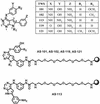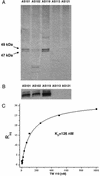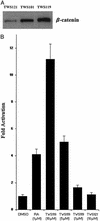Synthetic small molecules that control stem cell fate
- PMID: 12794184
- PMCID: PMC164638
- DOI: 10.1073/pnas.0732087100
Synthetic small molecules that control stem cell fate
Abstract
In an attempt to better understand and control the processes that regulate stem cell fate, we have set out to identify small molecules that induce neuronal differentiation in embryonic stem cells (ESCs). A high-throughput phenotypic cell-based screen of kinase-directed combinatorial libraries led to the discovery of TWS119, a 4,6-disubstituted pyrrolopyrimidine that can induce neurogenesis in murine ESCs. The target of TWS119 was shown to be glycogen synthase kinase-3beta (GSK-3beta) by both affinity-based and biochemical methods. This study provides evidence that GSK-3beta is involved in the induction of mammalian neurogenesis in ESCs. This and such other molecules are likely to provide insights into the molecular mechanisms that control stem cell fate, and may ultimately be useful to in vivo stem cell biology and therapy.
Figures




References
-
- Kim, J.-H., Auerbach, J. M., Rodríguez-Gómez, J. A., Velasco, I., Gavin, D., Lumelsky, N., Lee, S.-H., Nguyen, J., Sánchez-Pernaute, R., Bankiewicz, K. & McKay, R. (2002) Nature 418, 50–56. - PubMed
-
- Lumelsky, N., Blondel, O., Laeng, P., Velasco, I., Ravin, R. & McKay, R. (2001) Science 292, 1389–1394. - PubMed
-
- Tsai, R. Y. L., Kittappa, R. & McKay, R. (2002) Dev. Cell 2, 707–712. - PubMed
-
- Wichterle, H., Lieberam, I., Porter, J. & Jessell, T. (2002) Cell 110, 385–397. - PubMed
-
- Palmer, T. D., Takahashi, J. & Gage, F. H. (1997) Mol. Cell. Neurosci. 8, 389–404. - PubMed
Publication types
MeSH terms
Substances
LinkOut - more resources
Full Text Sources
Other Literature Sources
Medical
Molecular Biology Databases

